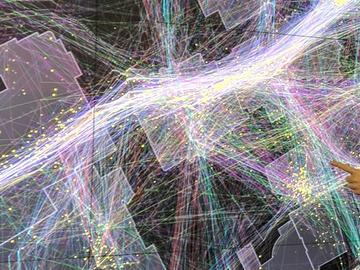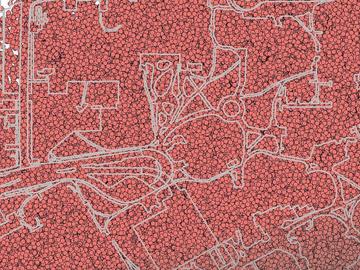
Mapping Human Experience: Evaluating Campus Restorative Green Spaces
Overview:
Angela Rout is a PhD candidate in Computational Media Design at the University of Calgary. Angela’s research has focused on how people use the campus, how they perceive the campus, and how to visualize this data for multiple applications. The foundational data set for her research was anonymized data from 300 students who volunteered to share how they moved around the campus via GPS locations from their smartphones. The data shows where students were at different points in time when on campus, as well as paths they took to walk across campus. Using this data, Angela’s research is comprised of three main components:
- Public Engagement – Study participants were asked where on campus they chose to locate a hypothetical outdoor student hub. After first asking participants that question, Angela showed them the smartphone data (i.e., how students currently use the campus) and asked them the same question; she measured the differences in participants’ responses before and after they saw the smartphone data. In most cases, the data made a difference in their response. To learn more, visit the journal article: Rout, A., & Galpern, P. (2018). Using personal smartphone location histories in public engagement: Locating a new campus amenity. Applied Geography, 100, 68-77.
- Smart Campus – Angela created a data visualization tool of the smartphone data to assist campus planners and architects design campus spaces. The visualization includes features like a comparison tool and filters to allow architects to explore how day of the week, different weather conditions, and makes a difference in student movement patterns. This work was supported by an internal sub-grant from the Taylor Family Digital Library, funded by the Andrew W. Mellon Foundation.
- Restorative Greenspaces – Using an online survey, Angela asked students what features they would like to see in greenspaces on campus. She then compared the survey responses with smartphone data demonstrating how students use existing greenspaces. Angela’s results suggest that students utilize greenspaces in close proximity to their classes, food outlets and other amenities. If designers don’t put greenspaces in convenient locations, they may be under-utilized. Additionally, benches did not significantly influence what spaces students used, however planters and low walls did. People will sit on whatever is available.
Outcomes:
- Presented at discussions for the University of Calgary Campus Master Plan. Her data was shared with them and will indirectly influence how campus architects and planners see things. The data confirms what we know or shows us new things and it creates a new way of seeing the campus.
- Published Rout, A., & Galpern, P. (2018). Using personal smartphone location histories in public engagement: Locating a new campus amenity. Applied Geography, 100, 68-77.
- Created Smart Campus visualization, code and raw data sets: https://smartcampus.ucalgary.ca/
- Co-authored Rout, A., & Galpern, P. (2020). Outdoor design features receive no regular use despite their high desirability: evidence from survey and smartphone tracking data: Landscape and Urban Planning, IN REVISION
Next Steps:
Angela is looking for ways to continue this type of work. She wants to explore how we can use tracking data to support better design in urban spaces; this likely involves collaboration with universities, design offices, and municipal governments. With regard to future research, it would be really interesting to revisit the data once new infrastructure is built. She hopes this will inspire others to conduct similar research to see how new designs change movement patterns. Will the places that people like to go to change once these buildings are complete?




